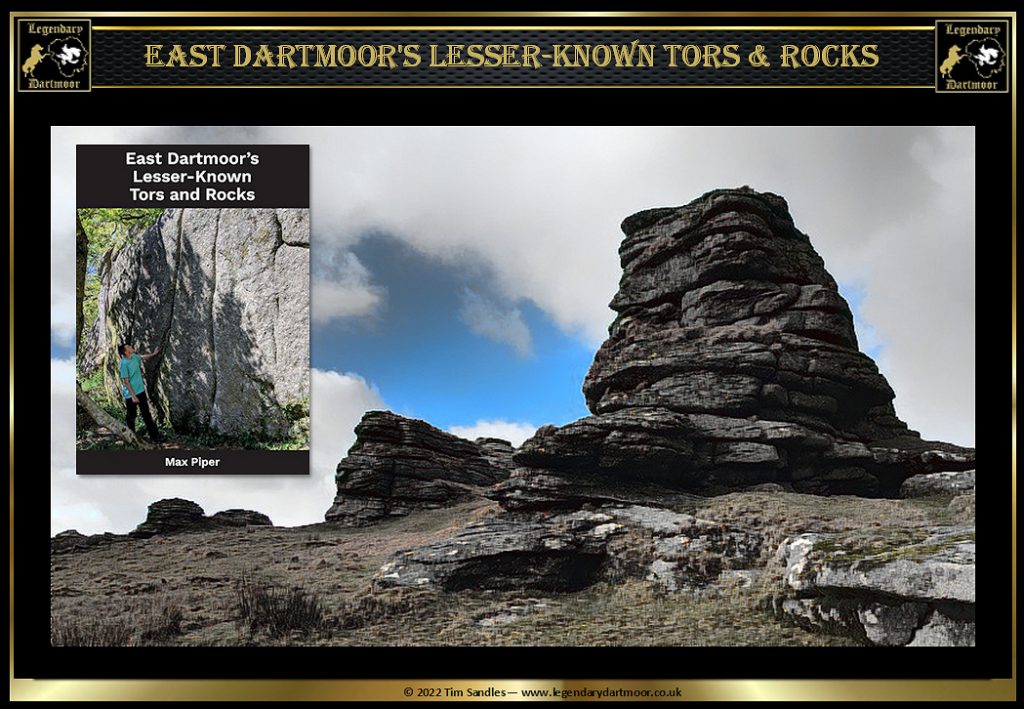
East Dartmoor’s Lesser-Known Tors and Rocks.
Published Date – 2022.
Published by – The Dartmoor Company.
ISBN – 978-0-9956902-2-6
Presentation – Soft back
Price – £24. (including postage)
Available from The Dartmoor Company, Amazon, etc.
It is said that the word “Tor” derives from the old Celtic name of “twr” that meant ‘tower’ which in many cases perfectly describes many of the Dartmoor tors. However there are numerous other smaller tors and rocks which certainly could not be describes as tower-like. If you look at the modern Ordnance Survey 1:25,000 map there are around 169 named tors but a plethora of tors, outcrops, and rocks, whose names for one reason or another have become lost. The author, Max Piper has along with Tim Jenkinson, Paul Buck, and Paul Rendell have spent many hours and walked countless miles in search of these nameless masses of granite. Such discoveries have become known as “Lesser-known Rocks and Tors’ which is the context of this newly published book that concentrates on the eastern side of Dartmoor – “East Dartmoor’s Lesser-known Rocks and Tors.” In Piper’s Words “The aim of this book is to provide information about each tor, including its appearance, location, and other points of interest, as well as supplying each one with a grid reference; an approximate height above sea level in metres, the access at the time of writing, who first described or found it, accompanied with references to a plethora of books, magazines, and other sources; and any alternative names.”
The book describes 300 individual tors and rocks, each one is accompanied by an evocative full colour photograph and its weight figure grid reference along with all that is described above. Also included is a useful chapter on the geology and topography of Eastern Dartmoor, an explanation of how the tors and rocks got their names and their meanings, a glossary of terms and a full page index. There is also an easy to follow map of the region with showing the relevant subject by its number which can then be cross-referenced with its page for the grid reference.
Each of the 367 pages makes for an interesting read that truly conjures up the majesty of these tors and rocks with the added benefit of their associated history, folk lore, and any inscriptions where applicable. In recent years there has been a surge in people wanting to visit the tors and rocks of Dartmoor and has become known as “Tor Bagging.” In this light I would consider this book which along with a map etc. is a ‘must have’ accompaniment. Likewise for anyone who has just a love or interest in Dartmoor then this title surely needs to be sat on their bookshelves. If you know of anyone that fits into these two categories then with Christmas just around the corner “East Dartymoor’s Lesser-Known Tors and Rocks’ would make an excellent present. I would also suggest that to fully appreciate and utilise the book’s information it is vital to have access to an Ordnance Survey 1:25,000 map either digitally or as a paper format. Presumably it is logical to suggest that at some point in time there will be southern, western, and northern versions of a similar form?
 Legendary Dartmoor The many aspects past and present of Dartmoor
Legendary Dartmoor The many aspects past and present of Dartmoor


Thank you for your kind review, Tim.
Thank you for book review Tim. Yes they may be others book in the series.